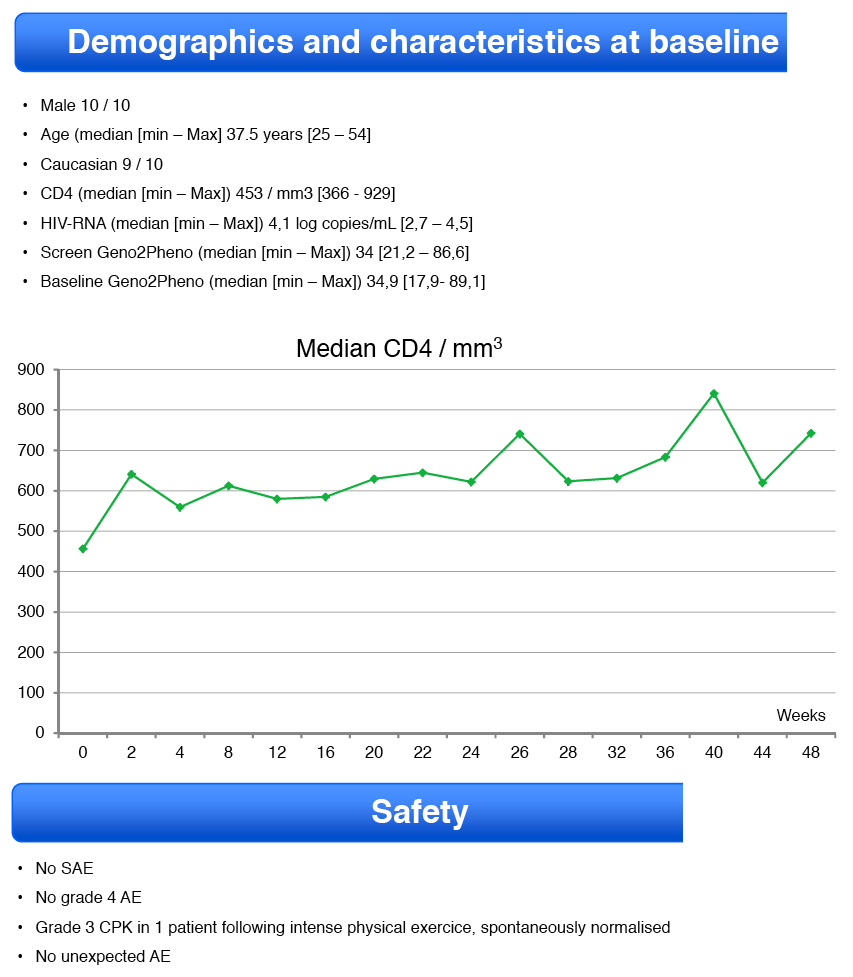 |
 |
 |
| |
Maintenance Maraviroc/Raltegravir Controls HIV in Preliminary 10-Person Analysis
|
| |
| |
7th IAS Conference on HIV Pathogenesis, Treatment and Prevention, June 30-July 3, 2013, Kuala Lumpur
Mark Mascolini
Preliminary results from the No Nuc No Boost study in France found that a maintenance regimen of maraviroc plus raltegravir sustained virologic control in 10 previously untreated people who began therapy with maraviroc/raltegravir plus tenofovir/emtricitabine for 24 weeks [1]. Results contrast with findings of the ROCnRAL trial, which found a high virologic failure rate with maraviroc/raltegravir maintenance in previously treated people [2].
Numerous trials, randomized and not, have tested regimens that exclude nucleosides in hopes of avoiding toxicities associated with those drugs. In Lyon and Nice, the No Nuc No Boost trial also avoids protease inhibitors (PIs) and nonnucleosides in a regimen including only the CCR5 antagonist maraviroc and the integrase inhibitor raltegravir [1]. Study participants had never taken antiretrovirals, had a CD4 count above 200, and had a viral load between 1000 and 100,000 copies. Everyone had HIV that uses the CCR5 coreceptor, and no one had resistance mutations associated with nucleosides, nonnucleosides, PIs, or integrase inhibitors. The trial excludes people with HBV infection or with HCV requiring treatment. People with low hemoglobin, neutrophils, platelets, or estimated glomerular filtration rate are excluded, as are people with high alkaline phosphatase, bilirubin, AST, or ALT.
All study participants begin maraviroc/raltegravir plus tenofovir/emtricitabine. Those with a viral load below 50 copies after 20 and 22 weeks of treatment stop tenofovir/emtricitabine at week 24 and continue the other two antiretrovirals. The primary endpoint is a viral load below 50 copies at week 48. After researchers recruited the first 10 people, enrollment stopped for 20 weeks then reopened for a second group of 30 participants.
This analysis focused on the first 10 participants, all of them men and 9 of them white. Median age stood at 37.5 years (interquartile range 25 to 54). CD4 counts ranged from 366 to 929 (median 453) and viral loads from 500 to about 31,600 copies (median 12,590 copies). All 10 men reached a viral load below 50 copies by week 8 of the induction phase, and all had a sub-50 load at week 48 of the maintenance phase. One person had an unconfirmed viral blip to 56 copies at week 44. Through 48 weeks median CD4 count rose from below 500 to above 700.
No study participants had a serious adverse event or grade 4 adverse event. One person had a grade 3 creatine phosphokinase elevation after intense exercise, which spontaneously returned to normal. There were no unexpected adverse events.
On the basis of these preliminary findings, the investigators proposed that maraviroc/raltegravir "appears a safe and effective antiretroviral treatment for this population." They stressed that their findings contrast with those of the ROCnRAL study, which tested maraviroc/raltegravir in antiretroviral-experienced people [2]. ROCnRAL participants had taken antiretrovirals for a median 15 years when they switched to the two-drug regimen with a viral load below 50 copies. Through 24 weeks of treatment, 5 of 44 study participants (11%) had virologic failure and 2 (4.5%) dropped out because of serious adverse events. Because of these findings, the Data and Safety Monitoring Board recommended stopping the trial. Raltegravir resistance mutations arose in 3 of 5 people with virologic failure, and virus in 1 person switched from the CCR5 coreceptor to CXCR4.
The No Nuc No Boost investigators outlined these differences between their study population and the ROCnRAL patients: (1) antiretroviral naive versus experienced, (2) median nadir CD4 count 453 versus 210, (3) antiretroviral duration 0 versus 15 years, (4) viral load before first combination regimen 4.1 log (about 12,590 copies) versus unknown, and (5) viral tropism determined in plasma versus peripheral blood mononuclear cells.
References
1. Cotte L, Durant J, Brochier C, et al. Safety and efficacy of maraviroc-raltegravir combination following 6 months induction with maraviroc-raltegravir-tenofovir-emtricitabine in naïve HIV-1-infected patients with CCR5 virus: interim analysis of the No Nuc No Boost study. 7th IAS Conference on HIV Pathogenesis, Treatment and Prevention, June 30-July 3, 2013, Kuala Lumpur. Abstract WEPE511.
2. Katlama C, Assoumou L, Valantin MA, et al. Maraviroc plus raltegravir dual therapy in aviremic HIV infected patients with lipodystrophy: results from the ROCnRAL ANRS 157 study. 20th Conference on Retroviruses and Opportunistic Infections. March 3-6, 2013. Atlanta. http://www.natap.org/2013/CROI/croi_179.htm





|
| |
|
 |
 |
|
|